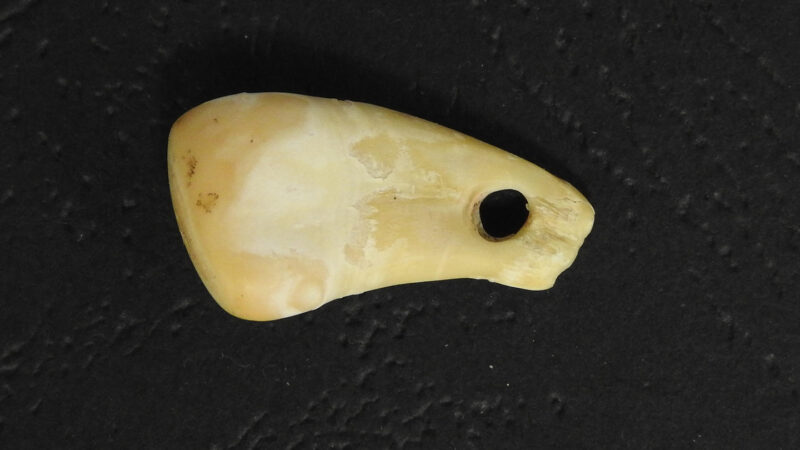A new, nondestructive way to recover ancient DNA has shown its potential for illuminating Stone Age people’s lives.
Genetic material extracted from a pierced deer tooth, possibly worn as a pendant, identifies its maker or wearer as a female Homo sapiens who lived roughly 20,000 years ago in Siberia, researchers report May 3 in Nature. Comparisons of DNA indicate that the female who handled the artifact was closely related to people who lived farther east in Siberia around the same time (SN: 8/28/14).
When applied to other finds, the technique could help clarify whether males and females alike made and used personal ornaments. And it could reveal whether H. sapiens or Neandertals made certain types of tools and ornaments in parts of Eurasia once occupied by both species at the same time.
“By extracting DNA from tools and ornaments directly, we can now begin to study the division of labor and the role of individuals [from different Homo species] in Pleistocene societies,” says molecular biologist Elena Essel of the Max Planck Institute for Evolutionary Anthropology in Leipzig, Germany.
Researchers usually extract ancient DNA from small amounts of powder drilled out of bones and teeth. Evolutionary geneticist Svante Pääbo, also at Max Planck, won the 2022 Nobel Prize in physiology or medicine for developing that method (SN: 10/3/22). But there is understandable reticence to drill into and disfigure, or potentially destroy, rare and delicate finds such as pendants and other ornaments. H. sapiens and Neandertal DNA can also be isolated from artifact-bearing sediment (SN: 4/15/21). But that DNA cannot identify the sex or species of who handled specific tools or ornaments.
In the new study, Essel, Pääbo and colleagues describe their method for ancient DNA extraction, which involves submerging bone and tooth artifacts in a sodium phosphate solution for three 30-minute periods at each of four temperatures. Objects are first placed in a room temperature solution, followed by three increasingly hotter solutions, ending at 90° Celsius.
Treatment at the highest temperature released human DNA that had penetrated deeply into the tooth artifact via extensive contact when it was made or used, the researchers say. Milder solution temperatures yielded ancient DNA closer to the pendant’s surface that originated from surrounding sediment, including that of an elk species.
Analyses of recovered human and elk mitochondrial DNA, usually inherited from mothers, generated an age estimate for the pendant of roughly 18,500 to 24,700 years old. That’s consistent with radiocarbon dates for burned wood that the researchers unearthed near the pendant. Radiocarbon dates are more precise than those generated from ancient DNA but cannot always be obtained from fragile or small artifacts, Essel says.
Two coauthors of the new study — archaeologists Maxim Kozlikin and Michael Shunkov of the Institute of Archaeology and Ethnology of the Siberian Branch of the Russian Academy of Sciences in Novosibirsk — directed a 2019 excavation that produced the newly analyzed pierced tooth at Siberia’s Denisova Cave (SN: 1/30/19).
Neandertals and other Stone Age hominids called Denisovans periodically occupied this site from nearly 300,000 years ago until around 55,000 years ago. Bone tools and personal ornaments found in previous digs indicated that H. sapiens visited Denisova Cave as early as around 30,000 years ago. Excavators in 2019 wore gloves and face masks to minimize contamination of unearthed objects with their own DNA.
In future work, archaeologists will need to use those anticontamination measures and more, including refrigeration of freshly excavated artifacts, to boost the ability of the new technique to ferret out ancient DNA, Essel says.
In tests her group conducted with 11 nonhuman animal bones previously excavated at a 35,000- to 45,000-year-old French site, the nondestructive DNA technique largely identified genetic material from people who had handled the finds without gloves during or after the dig.
The new technique could help determine whether H. sapiens or Neandertals made bone pendants and stone tools dating to as early as around 45,000 years ago at several sites in southwestern Europe, says evolutionary geneticist Carles Lalueza-Fox of the Institute of Evolutionary Biology in Barcelona who did not participate in the new study. Scientists disagree whether distinctive stone tools found with those ornaments were products of H. sapiens or Neandertals (SN: 5/9/06).


